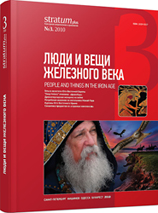Посуда из скифских погребальных комплексов Рогачикского курганного поля
Pottery from Scythian Burial Complexes of Rogachik Barrow Massive
Author(s): Yuri V. Boltryk, Elena E. FialkoSubject(s): History, Archaeology
Published by: Издательский дом Stratum, Университет «Высшая антропологическая школа»
Keywords: Dnieper-Molochansk steppe region; Scythians; barrows; burial rites; utensils; bronze cauldrons
Summary/Abstract: Rogachik barrow massive is a part of the main cluster of burial sites in the center of Scythia. Excavations of barrows were conducted in 1914, 1976—77 and 1990. Forty-three Scythian barrows containing 81 graves were studied on the border of two regions — Zaporizhia and Kherson.Despite the fact that most of the graves were plundered in ancient times, they maintained a representative series of the pottery. It is diverse by material (clay, metal, wood, alabaster) and also by utilization (tare, cookware, for perfumes and cosmetic).Pottery is represented by local molded pots and imported black-glazed and red vessels. Mortar is one of the rare and earliest findings, which penetrated here, apparently, from outside of the Black Sea Coast zone. Imported pottery was often adapted by nomads to the needs of nomadic life. Black-glazed pottery usually was older than the other things of the accompanying goods.Amphoras make the oldest category of finds in the ceramic complex. Funeral feasts involving breaking of amphoras and including dozens of vessels were part of the Scythian burial rite.The local pottery is represented by wooden bowls and bronze all-cast cauldrons. Imported metal pottery (louterion, kylix, situla) remained fragmented.Collection of the pottery from Rogachik barrow massive demonstrates a variety of funeral requisites of the Scythians. Indirectly, it reflects the social heterogeneity of the Scythian society, especially manifested in the second half of the 4 th century BC. And, at the same time, it shows active erosion of the Scythian material culture of this period by Ancient artifacts, which were penetrating the nomadic environment in various ways.
Journal: Stratum plus. Археология и культурная антропология
- Issue Year: 2010
- Issue No: 3
- Page Range: 289-323
- Page Count: 35
- Language: Russian

